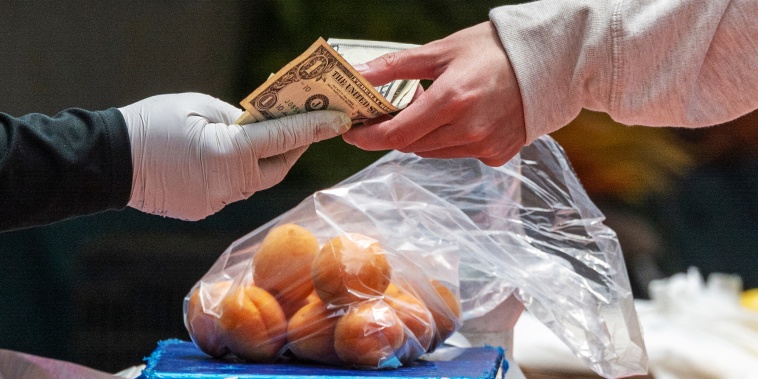Inflation climbed from 3.1% to 3.4% in December, a sign the Federal Reserve will continue to have to wrestle consumer price growth down to its desired 2% level.
Forecasts had been for a reading of 3.2%.
On a monthly basis, inflation hit 0.3%, while core inflation, which strips away the more volatile costs of food and energy, was 3.9%, down from 4% in November but ahead of forecasts for a reading of 3.8%.
The biggest contributors to December’s pickup in price growth were housing and shelter costs, which the Bureau of Labor Statistics said accounted for more than half of the gain. On a year over year basis, total shelter costs increased 6.2%, while rents increased 6.5%.
‘As long as shelter inflation remains stubbornly elevated, the Fed will keep pushing back at the idea of imminent rate cuts,’ said Seema Shah, chief global strategist at Principal Asset Management, in a note to clients following the Thursday data release.
Yet economists also said these increases are unlikely to last given other real-time measures of housing costs showing cooling price growth. In its most recent rental report, the real estate group Redfin said the median asking rent in the U.S. fell for the third-straight month in December to $1,964.
The decline came as landlords grappled with rising vacancies due to a post-pandemic building boom, Redfin said.
Indeed, there are signs consumers are starting to feel better about the economy — even though, to many of them, the prices they’re experiencing still don’t feel like a big improvement.
After two years of breakneck inflation that sent the cost of everyday goods and services surging, 2023 experienced a meaningful slowdown in price growth: the December 3.4% reading is down from the 6.4% growth seen in December 2022.
Thursday’s reading is still above the Federal Reserve’s inflation target of 2%, and prices in most cases aren’t actually reversing. As a result, the shell shock of the past 24 months for consumers is still wearing off.
“The good news is the rate of inflation has been steadily moderating and moving closer to the ultimate goal of 2%,” said Greg McBride, a vice president and the chief financial analyst at Bankrate. “The bad news is it doesn’t mean prices are actually falling — just that they’re not going up as fast.”
Two of the categories most affecting consumers — food at home and energy prices — have had more aggressive slowdowns in price growth than many other categories, McBride said. After hitting a high of 13.5% in August 2022, 12-month food price growth slowed to 1.3% in December, the BLS said Thursday.
And gas prices, which surged to almost $5 a gallon on average in June 2022, are now about $3 a gallon.
While Russia’s invasion of Ukraine produced an acute price surge for those two categories in 2021, McBride said their price growth has slowed thanks to a broader slowdown in economic growth — a trend that is likely to continue. The World Bank announced this week that it expects worldwide gross domestic product to hit just 2.4% this year, down from 2.6% in 2023, 3.0% in 2022 and 6.2% in 2021.
Yet, consumers still face everyday prices that are above pre-pandemic levels. White bread, which cost about $1.30 per pound in the winter of 2019-20, now costs about $2 per pound, according to BLS data. Ground beef has increased from about $3.87 a pound to $5.35 a pound over the same period. And a gallon of milk has climbed from roughly $3.20 to about $4.
So even as price growth continues to moderate, consumers are still adapting to a new normal.
“Consumer sentiment is still depressed overall,” said Matt Bush, the U.S. economist at Guggenheim Investments. “While the rate of inflation is slowing down, the absolute level is still really high — consumers are still unhappy with the level of prices.”
There are signs that consumer sentiment is slowly turning around now that wage growth has surpassed the rate of inflation.
Consumer confidence jumped in the final month of last year to its highest level since July. Data released Friday showed employers added 216,000 jobs in December, far more than expected, demonstrating the labor market remains robust even as it cools down.
Against that backdrop, some economists view even potentially concerning trends, like consumers’ ballooning debt burdens, as a sign that people are starting to feel a bit more optimistic as price pressures ease.
“They’re taking on additional debt because they expect to make more money,” said Joe Brusuelas, chief economist at the consulting firm RSM. Consumer debt figures don’t always paint a full picture, in part because wealthier Americans tend to borrow and repay more money at faster rates, he said. But even so, many consumers “have the capacity to pay that debt back” despite higher interest rates on credit cards to mortgages and auto loans.
“In many ways, it’s an expression of confidence,” he added.
Mark Zandi, chief economist at Moody’s, said that even as wage growth slows, it should still continue to stay above inflation.
For consumers, that means real — if small — gains.
‘With each passing month, it gets a teeny bit better,’ Zandi said. He continued: ‘There’s a slightly brighter hue in terms of people’s responses. It’s not an event; it’s a process — the feeling that wages are outpacing inflation, that purchasing power [is] improving. That’s what’s happening, but it will take a while to convince to people it’s real and sustainable.’

